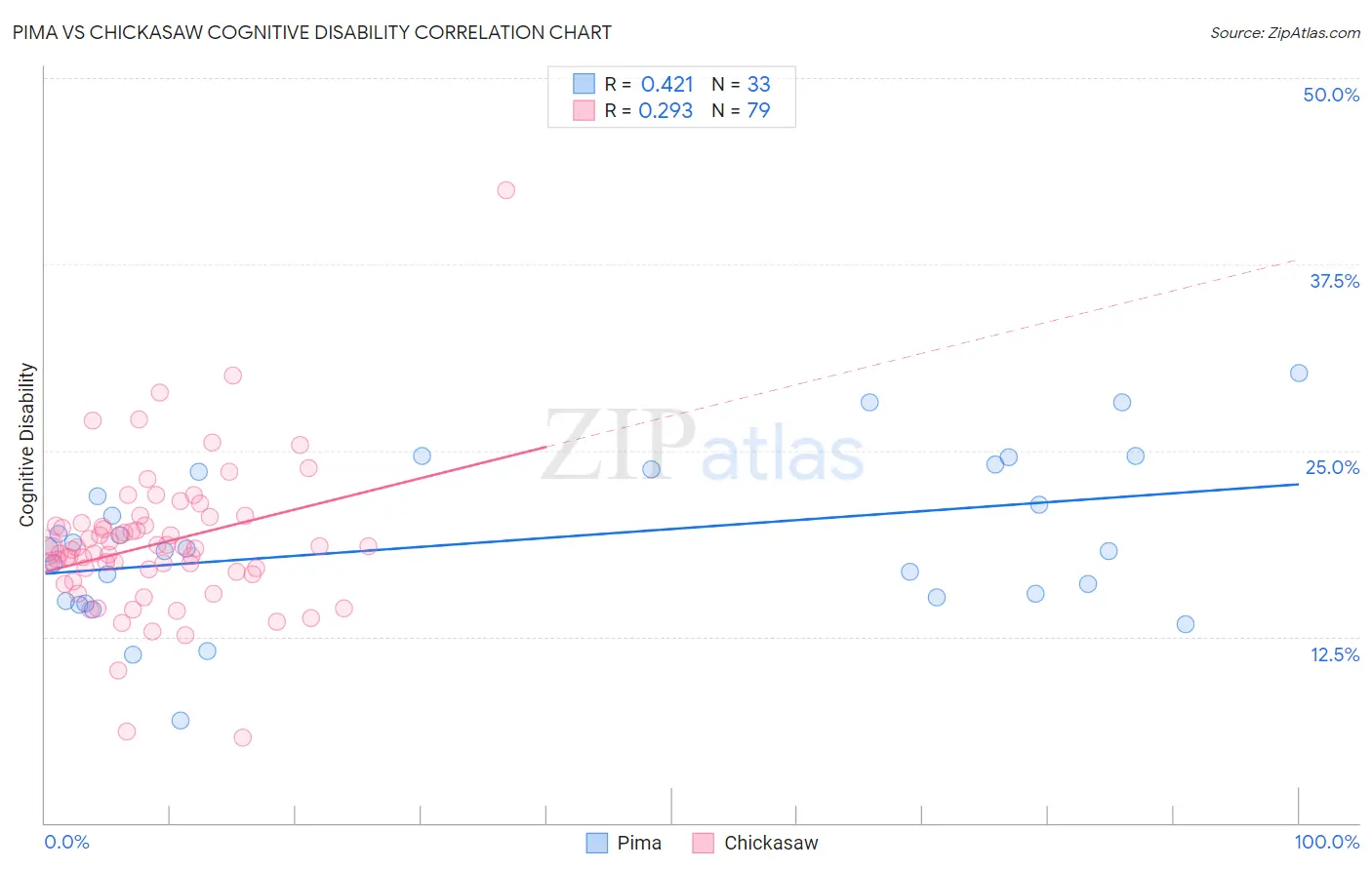Pima vs Chickasaw Cognitive Disability
COMPARE
Pima
Chickasaw
Cognitive Disability
Cognitive Disability Comparison
Pima
Chickasaw
18.8%
COGNITIVE DISABILITY
0.0/ 100
METRIC RATING
331st/ 347
METRIC RANK
18.5%
COGNITIVE DISABILITY
0.0/ 100
METRIC RATING
312th/ 347
METRIC RANK
Pima vs Chickasaw Cognitive Disability Correlation Chart
The statistical analysis conducted on geographies consisting of 61,542,171 people shows a moderate positive correlation between the proportion of Pima and percentage of population with cognitive disability in the United States with a correlation coefficient (R) of 0.421 and weighted average of 18.8%. Similarly, the statistical analysis conducted on geographies consisting of 147,689,565 people shows a weak positive correlation between the proportion of Chickasaw and percentage of population with cognitive disability in the United States with a correlation coefficient (R) of 0.293 and weighted average of 18.5%, a difference of 1.6%.

Cognitive Disability Correlation Summary
| Measurement | Pima | Chickasaw |
| Minimum | 6.9% | 5.7% |
| Maximum | 30.2% | 42.5% |
| Range | 23.3% | 36.8% |
| Mean | 19.0% | 18.7% |
| Median | 18.4% | 18.5% |
| Interquartile 25% (IQ1) | 15.0% | 16.9% |
| Interquartile 75% (IQ3) | 23.6% | 20.0% |
| Interquartile Range (IQR) | 8.6% | 3.1% |
| Standard Deviation (Sample) | 5.3% | 4.9% |
| Standard Deviation (Population) | 5.2% | 4.9% |
Demographics Similar to Pima and Chickasaw by Cognitive Disability
In terms of cognitive disability, the demographic groups most similar to Pima are Immigrants from Dominican Republic (18.8%, a difference of 0.070%), Navajo (18.8%, a difference of 0.16%), Kiowa (18.7%, a difference of 0.39%), U.S. Virgin Islander (18.7%, a difference of 0.45%), and Immigrants from Senegal (18.7%, a difference of 0.49%). Similarly, the demographic groups most similar to Chickasaw are Yaqui (18.5%, a difference of 0.11%), Subsaharan African (18.5%, a difference of 0.17%), Hmong (18.4%, a difference of 0.29%), Immigrants from Dominica (18.6%, a difference of 0.35%), and Immigrants from Middle Africa (18.6%, a difference of 0.43%).
| Demographics | Rating | Rank | Cognitive Disability |
| Hmong | 0.0 /100 | #311 | Tragic 18.4% |
| Chickasaw | 0.0 /100 | #312 | Tragic 18.5% |
| Yaqui | 0.0 /100 | #313 | Tragic 18.5% |
| Sub-Saharan Africans | 0.0 /100 | #314 | Tragic 18.5% |
| Immigrants | Dominica | 0.0 /100 | #315 | Tragic 18.6% |
| Immigrants | Middle Africa | 0.0 /100 | #316 | Tragic 18.6% |
| Liberians | 0.0 /100 | #317 | Tragic 18.6% |
| Bangladeshis | 0.0 /100 | #318 | Tragic 18.6% |
| Comanche | 0.0 /100 | #319 | Tragic 18.6% |
| Apache | 0.0 /100 | #320 | Tragic 18.6% |
| Africans | 0.0 /100 | #321 | Tragic 18.6% |
| Immigrants | Liberia | 0.0 /100 | #322 | Tragic 18.7% |
| Pueblo | 0.0 /100 | #323 | Tragic 18.7% |
| Dominicans | 0.0 /100 | #324 | Tragic 18.7% |
| Indonesians | 0.0 /100 | #325 | Tragic 18.7% |
| Immigrants | Senegal | 0.0 /100 | #326 | Tragic 18.7% |
| U.S. Virgin Islanders | 0.0 /100 | #327 | Tragic 18.7% |
| Kiowa | 0.0 /100 | #328 | Tragic 18.7% |
| Navajo | 0.0 /100 | #329 | Tragic 18.8% |
| Immigrants | Dominican Republic | 0.0 /100 | #330 | Tragic 18.8% |
| Pima | 0.0 /100 | #331 | Tragic 18.8% |